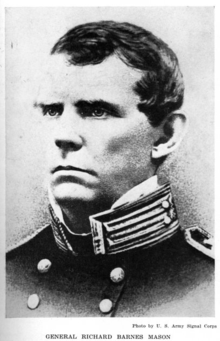Richard Barnes Mason
| Richard Barnes Mason | |
|---|---|
 | |
| 4th Military Governor of California | |
|
In office 1847–1849 | |
| Preceded by | Stephen W. Kearny |
| Succeeded by | Persifor Frazer Smith |
| Personal details | |
| Born |
January 16, 1797 Lexington Plantation, Fairfax County, Virginia |
| Died |
July 25, 1850 (aged 53) Jefferson Barracks, St Louis, Missouri |
| Political party | Democratic |
| Spouse(s) | Elizabeth Margaret Hunter |
| Profession | Soldier |
| Military service | |
| Allegiance |
|
| Service/branch |
|
| Years of service | 1817 - 1850 |
| Rank |
|
| Unit |
8th U.S. Infantry 1st U.S. Infantry |
| Commands |
Fort Gibson Jefferson Barracks |
| Battles/wars |
Black Hawk War Second Seminole War Mexican-American War |
Richard Barnes Mason (January 16, 1797 – July 25, 1850)[1] was a career officer in the United States Army and the fourth military governor of California before it became a U.S. state. He came from an ancient American family and was a descendant of George Mason, a framer of the U.S. Constitution and father of the Bill of Rights.
Gen. Mason is especially important to the history of California, because as military governor, he wrote the official report that led to the California Gold Rush.[2][3]
Mason was "an aristocratic Virginian, a large portly man, six feet in height. He possessed all the peculiarities of a Southerner, accentuated," but he was known to have confined Jefferson Davis to quarters, who was under his command.[4] A Lt. James Abert described him so, "It would be presumption in me to speak of so accomplished and well known an officer; but I cannot refrain from expressing my grateful sense of the kindness and hospitality with which we were received and treated by himself and his amiable lady, and indeed, by all the officers and ladies attached to the command."[5]
Early life
"Richard Barnes Mason, born in Fairfax County, Virginia, January 16, 1797, was the son of George Mason and Elizabeth Mary Ann Barnes Hooe, who were married April 22, 1784."[6]
Military career
Mason was commissioned into the Army in 1817 and served in the 1st U.S. Infantry during the Black Hawk War. In 1833, he transferred to the 1st U.S. Dragoons as its first Major. He was promoted to Lieutenant Colonel in 1836. During the Mexican-American War, he served in New Mexico Territory and California, rising to the rank of Colonel in 1846.[5]
Following the war, he was appointed military governor of California, serving from May 31, 1847, until April 13, 1849. When gold was discovered at Sutter's Mill, Mason made a report of the finding to President James K. Polk. That official description of the massive gold discovery is credited with sparking the California Gold Rush, resulting in the settlement of the land.[5]
Mason died in 1850 at Jefferson Barracks in St. Louis, Missouri and was buried at Bellefontaine Cemetery.[1][5]
In the US Federal Census of 1850 for Jefferson Barracks, St. Louis County, Missouri, dated 18 August 1850, the following annotation is located at the bottom of the third page: "Brig Genl Mason died at Jefferson Barracks July 1849 of Cholera."[7] However, The St. Louis Intelligencer reported the General's death on Saturday, July 27, 1850, (p. 3, cols. 1, 4.)[8]
Marriage and children
Mason married Elizabeth Margaret Hunter on 28 January 1836.[1] Richard and Elizabeth had three daughters:[1]
- Emma Twiggs Mason Wheaton (17 October 1836–16 February 1864)[1]
- Elizabeth Mary Ann Sally Mason (20 August 1838–19 November 1912)[1]
- Alice Graham Mason (c. 1843–10 February 1847)[1]
Honours
In 1882, the Post at Point San Jose in San Francisco, California was renamed Fort Mason in his honour, and served as an Army base for more than 100 years.[9] There is also a Mason Street in downtown San Francisco.
Relations
Richard Barnes Mason was a grandson of George Mason (1725–1792);[1] son of George Mason V (1753–1796);[1] brother of George Mason VI (1786–1834);[1] grandnephew of Thomson Mason (1733–1785);[1] first cousin once removed of Stevens Thomson Mason (1760–1803), John Thomson Mason (1765–1824), and William Temple Thomson Mason (1782–1862);[1] first cousin of Thomson Francis Mason (1785–1838) and James Murray Mason (1798–1871);[1] second cousin of Armistead Thomson Mason (1787–1819), John Thomson Mason (1787–1850), and John Thomson Mason, Jr. (1815–1873);[1] and second cousin once removed of Stevens Thomson Mason (1811–1843).[1]
Ancestry
| Ancestors of Richard Barnes Mason | |||||||||||||||||||||||||||||||||||||||||||||||||||||||||||||||||||||||||||||||||||||||||||||||||||||||||||||||||||||||||||||||||||||||||||||||||||||||||||||||||||||||||||||||||||||||||||||||||||||||||||||||||||||||||||||||||||||||||||||||||||||||||||||||||||||||||||||||||||||||||||||||||||||||||||||||||||||||||||||||||||||||||||||||||||||||||||||||||||||||||||||||||||||||||||||||||||||||||||||||||||||||||||||||||||||||||||||||||||||||||||||||||||||||||||||||||||||||||||||||||||||||||||||||||||||||
|---|---|---|---|---|---|---|---|---|---|---|---|---|---|---|---|---|---|---|---|---|---|---|---|---|---|---|---|---|---|---|---|---|---|---|---|---|---|---|---|---|---|---|---|---|---|---|---|---|---|---|---|---|---|---|---|---|---|---|---|---|---|---|---|---|---|---|---|---|---|---|---|---|---|---|---|---|---|---|---|---|---|---|---|---|---|---|---|---|---|---|---|---|---|---|---|---|---|---|---|---|---|---|---|---|---|---|---|---|---|---|---|---|---|---|---|---|---|---|---|---|---|---|---|---|---|---|---|---|---|---|---|---|---|---|---|---|---|---|---|---|---|---|---|---|---|---|---|---|---|---|---|---|---|---|---|---|---|---|---|---|---|---|---|---|---|---|---|---|---|---|---|---|---|---|---|---|---|---|---|---|---|---|---|---|---|---|---|---|---|---|---|---|---|---|---|---|---|---|---|---|---|---|---|---|---|---|---|---|---|---|---|---|---|---|---|---|---|---|---|---|---|---|---|---|---|---|---|---|---|---|---|---|---|---|---|---|---|---|---|---|---|---|---|---|---|---|---|---|---|---|---|---|---|---|---|---|---|---|---|---|---|---|---|---|---|---|---|---|---|---|---|---|---|---|---|---|---|---|---|---|---|---|---|---|---|---|---|---|---|---|---|---|---|---|---|---|---|---|---|---|---|---|---|---|---|---|---|---|---|---|---|---|---|---|---|---|---|---|---|---|---|---|---|---|---|---|---|---|---|---|---|---|---|---|---|---|---|---|---|---|---|---|---|---|---|---|---|---|---|---|---|---|---|---|---|---|---|---|---|---|---|---|---|---|---|---|---|---|---|---|---|---|---|---|---|---|---|---|---|---|---|---|---|---|---|---|---|---|---|---|---|---|---|---|---|---|---|---|---|---|---|---|---|---|---|---|---|---|---|---|---|---|---|---|---|---|---|---|---|---|---|---|---|---|---|---|---|---|---|---|---|---|---|---|---|---|---|---|---|---|---|---|---|---|---|---|---|---|---|---|---|---|---|---|---|---|---|---|---|---|---|---|---|---|---|---|---|---|---|---|---|---|---|---|---|---|---|---|---|---|---|---|---|---|---|---|---|---|---|---|---|---|---|---|---|---|---|---|---|---|---|---|---|
| |||||||||||||||||||||||||||||||||||||||||||||||||||||||||||||||||||||||||||||||||||||||||||||||||||||||||||||||||||||||||||||||||||||||||||||||||||||||||||||||||||||||||||||||||||||||||||||||||||||||||||||||||||||||||||||||||||||||||||||||||||||||||||||||||||||||||||||||||||||||||||||||||||||||||||||||||||||||||||||||||||||||||||||||||||||||||||||||||||||||||||||||||||||||||||||||||||||||||||||||||||||||||||||||||||||||||||||||||||||||||||||||||||||||||||||||||||||||||||||||||||||||||||||||||||||||
References
- 1 2 3 4 5 6 7 8 9 10 11 12 13 14 15 Gunston Hall. "Richard Barnes Mason". Gunston Hall. Retrieved 2008-02-15. External link in
|publisher=(help) - ↑ Mason's Report of the Gold Discovery
- ↑ John Putnam, "The official report that sparked the gold rush", 'My Gold Rush Tales.'
- ↑ James C. Parrott, Annals of Iowa, Des Moines, Fort Des Moines (No. 1), Iowa, vol. III, nos. 5-6, Third Series, p. 367.
- 1 2 3 4 Caroyln Foreman (March 1941). "Chronicles of Oklahoma,". Oklahoma Historical Society. 19 (1): 15–36. OCLC 1554537. Retrieved 2007-05-17.
- ↑ CAROLYN THOMAS FOREMAN, "GENERAL RICHARD BARNES MASON," 'Chronicles of Oklahoma', Volume 19, No. 1 March, 1941.
- ↑ http://interactive.ancestry.com/8054/4200574_00014/?htx=View&r=an&dbid=8054&iid=4200574_00014&fn=Margareth&ln=Mason&st=r&ssrc=&pid=4053306
- ↑ http://digital.library.okstate.edu/Chronicles/v019/v019p014.html
- ↑ "Golden Gate National Recreation Area - Fort Mason History Walk" (PDF). National Park Service. p. 12. Retrieved 2007-12-18.
